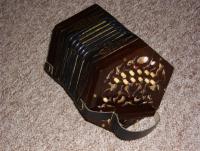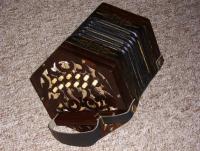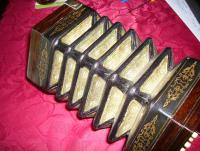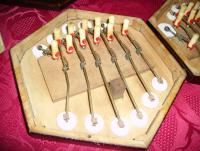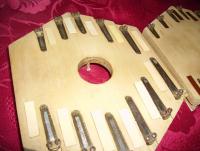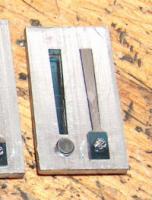
accordionmagic
Members-
Posts
80 -
Joined
-
Last visited
Everything posted by accordionmagic
-
Thanks for those kind remarks. Its actually not a retrofit, this is a new instrument. The ends are machined entirely from solid timber on my CNC machine! The mechanism is almost identical to a traditional Jeffries. There are many difficulties developing something like this, namely speaker enclosure/size/shape, battery type/size/location/lifetime, MIDI expander location, amplifier power/voltage/current consumption/efficiency, bellows pressure measurement, SOFTWARE, the list goes on................. Bellows are relatively easy to make, even in the traditional way but even cheap ones cost £150+ in the UK. When it comes to mass production, definitely possible BUT expensive to set up. If I wasn't already an electronics engineer AND a concertina maker/repairer then I would need to find people who were! The instrument in the videos is packed with separate electronic 'modules', some off the shelf and some (4) of my own design and construction. These would need to be re-designed and a TOTAL of 4 modules/pcb's should suffice. Luckily I found a guy (in the videos) who was prepared to invest and who had the patience to wait while I tried various ideas. My own opinion is that to flood the market with cheap, plastic, printed instruments would be akin to replacing the worlds pianos with xylophones. (I cant stand what Bose has done to traditional speakers) Ok, you cant print wood.......................... or could you? The danger is going too far and producing a toy. Something in-between would be better. How about CNC ends and printed mechanism. Finally, have you seen how slow a 3D printer is? Cheers for now
-
OK, well here it is............................... I believe this to be the very first totally self contained MIDI concertina!!!!!!!!!!!!! If anyone knows of an equivalent then I shall withdraw that statement if you show me video evidence! . It's a 36 key Anglo, traditional riveted action, BUT in place of the reeds is a MIDI controller/stereo GM expander/power amp/speakersx2. It's battery powered (12 hours), has 'clever' bellows sensitivity and a hefty audio output from the full range enclosed speakers. It also has a stereo 'line out', a mute for the internal amp and the controller/expander can run from a normal power supply with or without batteries. This has taken MANY months to complete during my quieter periods BUT is possibly the most satisfying project that I've ever undertaken! This instrument FEELS real because of the vibrations from the speakers, something I had not truly anticipated. This particular instrument is now in the hands of it's very patient new owner/test pilot............. Please watch the following Youtube vids: https://www.youtube.com/watch?v=Lo8VGP4nTOE https://www.youtube.com/watch?v=NjbiflsBvgY https://www.youtube.com/watch?v=zxzwN6vTpQ0 https://www.youtube.com/watch?v=ciD7Mz0J3zo https://www.youtube.com/watch?v=NIRwnU-6hBI
-
Jeffries 22 Key For Sale, Unusual Pitch
accordionmagic replied to accordionmagic's topic in Buy & Sell
Well............. regarding value, did I mention how rare this is? I'm not sure right now how much to ask, I'm in no particular hurry. If you do a search for this very instrument like I have I think you will end up with a blank page! The only B/F# I can find with reed shoes like this one (actually stamped as being those of a 'real' B/F#) is another Jeffries, but with 38 keys. Searching for 22 key instruments reveals only Lachenal and George Jones instruments. I'm not saying that there aren't any of these around but my goodness, I cant find one anywhere. Roy -
Jeffries 22 Key For Sale, Unusual Pitch
accordionmagic replied to accordionmagic's topic in Buy & Sell
Hi Richard, Sure, Ill do my best Roy -
This is a Jeffries stamped 22 key rosewood/bone button B/F# Anglo in concert pitch. This was basically a scrapper but I've restored it to 'used' condition because of it's tuning. I have read much about B/F# tuning and have read that this is really a Bb/F in a different pitch but in this case I must disagree. The tuning is correct as each note is tuned as per what is stamped on the actual reed!: The ONLY exception to this is the extra right hand button D5/C5. Left hand; B2/F#3 F#3/A#3 B3/C#4 D#4/E4 F#4/G#4 F##(G)4/A4 A#3/C#4 C#4/F4 F#4/G#4 A#4/B4 C#5/D#5 Right hand; B4/A#4 D#5/C#5 F#5/E5 B5/G#5 D#6/A#5 D5/C5 F#5/E#(F)5 A#5/G#5 C#6/B5 F#6/D#6 A6/F6 My intention was to retain as much original material as possible, especially in the bellows so although the leather has been restored (very carefully) the papers are all original. All reeds have been dismantled/cleaned/reassembled and tuned. It wasn't far off concert pitch so I sharpened it a little. It has a lovely rounded wooden ended sound, the reeds are very responsive and it is quite LOUD. New Springs/Pads/Valves/reed pan leather strips etc. It is now for sale, I've listed it here first for one or two weeks and then it's Ebay. It can be viewed at my workshop in Cheshire. Cheers Roy Whiteley, Accordion Magic Tel:07519064196
-
I can't get hold of small quantities of small diameter black delrin but have loads of 6mm white. This can be dyed very easily using the correct dye to almost any colour, handy for special buttons with special function etc. Delrin is extremely easy to turn and leaves a smooth finish after turning that doesn't need polishing further. Dyeing Delrin results in a deep colour layer that cannot be scratched off.
-
Hello all, Roy Whiteley here............... Hello Bruce, I don't know whats happening on the communication front? i'm sorry that you've not been able to reach me. No clue regarding phone but I'll check my junk email on Friday (not in work tomorrow). My MIDI concertina history: First English completed in 2004. There are currently 40 something instruments out there, customers in UK, USA, Australia, Japan, South Africa, Spain, France............... Any concertina can be converted, English/anglo/duet/Chemnitzer, British/American/German or Chinese. Various methods exist mechanically, always magnets and sensors. Inside or outside of bellows. Mechanism always opens holes to simulate reed air consumption. Real time processor always, not pi. The pi is quick but not real time, it WILL miss events better used as a synth. Bellows pressure always measured and used with look up table and algorithm. Raw data can't be used. Internal GM MIDI expander can be fitted. Batteries should not be fitted deep inside the instrument. Currently assembling first MIDI concertina with internal expander and amp/speakers. When finished it will be fitted with OLED screen to improve the instrument setup system. It has 2 part ends milled from solid, I have the g-code and a CNC machine. Buttons turned from white Delrin dyed black, bushed. Bellows traditional. When it's complete I'll post images. Radio is coming also BUT forget ANY system that channel hops and handshakes, just too slow! The secret is NOT to send MIDI at all but something else and that's all I will say on that matter. I have provided kits in the past but I actually found this quite a job............ there are so many bits and pieces and an instruction manual to provide. More work than you would imagine. My intention is to make these available in larger quantities and cheaper than my 'gold' Jeffries type acoustics. I don't believe that you can make an instrument that feels like a real one for pennies though. Roy.
-
Hello All, You may be interested to know that John's collection of concertinas (including the MIDI that I built for him) are going on sale this month from 14th/15th at public auction. Here is the link to the auction site (good pictures of each concertina): Adam Partridge auction Here is the MIDI in action: Cheers
-
Anyone Seen These Papers Before?
accordionmagic replied to accordionmagic's topic in General Concertina Discussion
Hello and in summary then; Has anyone come across this pattern before? I am restoring this 31 key Anglo Lach Number 200234 Yes, some people have seen it before on both late Anglo AND English Lachenal models. These come with fibre boxes and Erinoid buttons and the words MADE IN ENGLAND or in the case above, just the word ENGLAND stamped on the side of a wooden end. So it's 1930 something at the end of production but are those Swastikas or 'patternations'........... or what. It's actually just a repeating 'Art Deco' type of pattern that some people see as overlapping lines such as those seen in basket weaving and Tweed fabrics and some people see as symbols resembling the 'swastika' symbol of the 'bad' WWII period and the 'nice' period before. Some people can only see one of the patterns (there may be dozens), others can see more than one at the same time and some people can choose which one to see ..... some people refuse to see I dont suppose Lachenal would have got away with this after 1939 or even earlier? any ideas? Well, I dont mean that he would have tried on purpose! but I think, given that at least some people can see the symbols that he would have changed the design at the time, had he still been in business. Anyway, should I replace these five fold bellows for a new set, would it put off potential buyers if they were left on after some repair? So long as I show the potential customer the paper design without uttering the words 'swastika' or 'symbol' or 'Art Deco' then they might actually like the design and buy the instrument so I will leave them on and fix em up like new. Before anyone asks, they are definately original. They are! Cheers and thanks to EVERYONE for this interesting thread. Roy -
Anyone Seen These Papers Before?
accordionmagic replied to accordionmagic's topic in General Concertina Discussion
Stephen, Yes, I've also seen these markings........ many times, but never associated them with.......well, anything! but thanks for pointing it out. Regarding my phrase " get away with it"; perhaps a bad choice of words. My real point was that perhaps the Brits amongst others would have preferred not to see these particular symbols during WWII even though Lachenal and the Brits would at the time (before the war) have considered the 'pattern' a completely innocent one and quite rightly so. Unfortunately, despite the immensely long and varied history of the symbol prior to WWII, it's meaning was changed dramatically by the Nazi's during WWII and is banned in Germany to this day! The following quote sums it all up; "Sixty years after World War II, few symbols are more immediately recognizable and more laden with horrific, historical baggage than the swastika. It stands for the Nazi machinery of murder, for the genocide perpetrated against European Jewry and the continent's Sinti and Roma population -- not to mention world history's most violent dictatorship. In Germany at least." You can read the rest here, http://www.spiegel.de/international/0,1518,337722,00.html So actually it's not just me! Dirge, I'm sorry you cant see them but hey, good for you. If you like the pattern for what it is, just that, a pattern, then thats fine. I must tell you this little story though............ In my former life as an engineer, I was priviledged enough to travel the world and worked in South Korea at the POSCO steel plant in Pohang a couple of times. During one stay I ventured into town to find some western food and as I walked through the high street I could see in the distance a flag jutting from a shop front, it was a black swastika on a white circle on a red background! As I neared the shop, the flag waved in the breaze and I tried to anticipate what on earth it could be, could it be the South Korean Nazi headquarters? surely not, did the Koreans get involved in WWII? I know they had big problems with the Japs, were they on our side? I eventually reached the shop and stood facing it, people walked in front of me and behind me as I stared at the clothes in the shop window and the sign over the door which said.........HITLER JEANS Work that one out unbelievable! The shop is there! This is a very sensitive subject in the west and must never be understated! I'm not sure whether to restore these strange bellows to proper working condition rather than replace them but I do also think that the papers are a nice period piece of the instrument! Cheers for now. -
Anyone Seen These Papers Before?
accordionmagic replied to accordionmagic's topic in General Concertina Discussion
OK everyone, thanks for the replies, I wasnt actually insisting that this was some kind of Nazi party Lachenal but just wondered if it was a Lachenal standard paper toward the end of production. Yes, I've seen them before on late-period Lachenals; the instrument probably also has buttons made of Erinoid plastic, a square fibre-board case, may be stamped MADE IN ENGLAND on its side, and could even have ferrous reed shoes? Yes to the buttons, fibre box is hexagonal, shoes are brass, MADE IN ENGLAND....yes its there. But I can't imagine how anyone could interpret the design as "swastikas" , it's simply Art Deco, like Odeon cinemas used to be, and would have been considered very fashionable and "modern" at the time. I think those papers are very attractive. I do understand the history of the symbol, if I didnt say 'Swastikas' how would you know what I meant? The design might have been considered fashionable at the time but taste is a personal thing ofcourse. The "swastikas", if that's what you want to call them seem to be incidental, an artifact of the way larger design elements meet at their corners. In fact, if you look again you should see that there are equal numbers of right-facing and left-facing "swastikas". Yep No, I don't think they would have gotten away with it more than five years after they closed. Humour I think if you don't mention the word "swastikas" while showing the concertina to anyone, I think they wouldn't mention "swastikas" either. To me it looks like a woven chair seat...under...over...under...over. Try to look at it differently. I suppose a few potential buyers might be put off, but I doubt that most would care, some might prefer the individuality, and many might not even notice the "swastika" if it weren't pointed out to them. In fact, I'm not sure I would have noticed. As I said, I'm sure it's an incidental artifact of the larger design, which reminds me of tweed. Hmmm, I've tried to ignore them but they wont go away! so far, no one has missed it, all I need to say is "what do you think"........ If my tweed jacket had that pattern on it I wouldnt bloody visit Germany! Cheers everyone Roy -
Hello everyone, Has anyone come across this pattern before? I am restoring this 31 key Anglo Lach Number 200234. So it's 1930 something at the end of production but are those Swastikas or 'patternations'........... or what. I dont suppose Lachenal would have got away with this after 1939 or even earlier? any ideas? Anyway, should I replace these five fold bellows for a new set, would it put off potential buyers if they were left on after some repair? Before anyone asks, they are definately original. Cheers Roy
-
There's Gold In Them Concertinas!
accordionmagic replied to accordionmagic's topic in Instrument Construction & Repair
Hi folks, Well finally here it is, my Jeffries based concertina with the gold plated bits and bobs. This one is now the property of Chris Algar, I will be making more, exclusively for sale by Chris. Metal ended next. Yes, those are Lachenal reeds but the Jeffries style construction does indeed seem to bring them to life. The construction is traditional where possible, kiln dried quarter sawn sycamore is used for the reed pans, action board/sound board and bellows frames with Rosewood veneered Mahogany everywhere else. The bellows are constructed from individual card pieces with a coloured paper top layer as shown, muslin hinges inside and under the morocco grained sheepskin. The leather is hand cut and skived from the same hide. All metal parts except for the springs are gold electroplated, this looks good and stops the rot. The end bolts are gold plated stainless steel. Hope you like it -
There's Gold In Them Concertinas!
accordionmagic replied to accordionmagic's topic in Instrument Construction & Repair
This is a Jeffries copy made entirely from scratch by myself. The rosewood ends have my own fretwork design but otherwise it is very similar, particularly the reed pans. It's in the final finishing stage now and will be finished by the end of the week. It has been my desire to produce a fine instrument and as such I believe the insides should reflect the same level of quality as the outside even if it's hidden from view! No expense has been spared. Hopefully the first of many. Roy -
There's Gold In Them Concertinas!
accordionmagic replied to accordionmagic's topic in Instrument Construction & Repair
Hello all, Thank you for your comments, the arms and pivots are made from brass sheet, these are gold plated after forming and polishing, the rivets are also plated. The button tops are turned from brass and drilled out to fit the top of the turned wooden part which is only slightly smaller in diameter. The tops are then rounded, polished and gold plated. Next time I may even do the springs (phospher bronze) All very time consuming but worth it I think. The ends are rosewood on this model with gold plated end bolts and detail. More pictures to follow. Cheers -
-
Simpleton...........! Incapable of seeing beyond your own limitations and yet incapable of demonstrating ones own capabilitities!!!!!!! Who are you? Lets see what you can do......... opinionated tosser!
-
Hello all, This 50 button has now been restored mechanically and the un-edited high res pictures can be found here 50 key webpage Just double-click on each file to open it. The first few show the original condition and the last dozen or so the finished article, the bits in between are for my records really and a bit repetative. Please note that as yet the metal ends and ebony are not restored. Take a look at the conjestion in the levers to the right of the right hand side. The last two images are the tuning as found at 454Hz i.e. Bb/F. Any ideas as to what the missing reed might be would be appreciated, marked with a '?' on the right. The reeds are actually stamped for a C/G BUT this is found only to be true at 404Hz !! Any ideas regarding why it should have been tuned so low? French chamber music ??? OR has it been changed to a high Bb/F to start with? The instrument plays very well indeed, loud as required but not harsh in any way. Regards Roy Whiteley
-
The complete Idiots guide to concertina MIDI: From above; for the price of a Jackie. If you want rubbish then pay rubbish! I fail to see why silent practice instrument should be of superb quality, comparable to Morse or Edgley or higher, and cost as much. It defeats the purpose, hence fewer orders, in my opinion. Concertina makers dont want to make rubbish and I would'nt want to put my name on rubbish! The purpose is where we dissagree. This next comment is a classic; Midi or any other electronic gadgets with guts sticking out and connected to other electronic toys are not music essentials. I don't see the niche for high quality MIDI concertina, kill me. It's a toy. What you need is a Stylophone! see Rolf. Silent practice is entirely different matter, it's often the matter of playing an instrument or not. It may even be completey without any pressure censors or buttons at all, just a paper map. New I was going wrong somewhere! I bet I could get a tune out of one of those! I realize the time for development is costly and the market is small, but I also realize the miss in final goal. MIDI and the likes exist NOT to replace live symphony, but to make it happen. I haven't seen this approach yet. Rather it's either Bentley or none. Inevitably, except for some rare cases it's mostly none. I dont beleive that making a small number of quality instruments for discerning players miss's the final goal, If you turn every 1 out of three enquiries into an order, it's huge and enormous success, probably due to the word of mouth and the quality you deliver. Correct On the other hand, I've seen many MIDI accordions in action - none of them will make anything musically, it's not even on the agenda. Most just plug various sounds and change them tastlessly at will: now it's horns and now it's strings. OMG, I will show this to Pearl Fawcett on Friday when she comes to my home. She has been the world champion, is a Professor of music and is regarded as one of the finest accordionists of all time! And guess what....... she has a MIDI system fitted to her one off hand made Italian accordion. I'll point out the tasteless part just for you! Look her up and get an education! DOH Older people, who by some obscured reason want to play large PAs standing, might benefit from the lightness of reedless instruments, but it's not essential for concertinas. Did you want one or not? Next time I see a live band, I'll suggest they should sit. I also realize that most developers just want to have reward and not slug through the monotone labor just to survive, be there money or not. I actually manage somehow to scrape a living by restoring quality instruments to their former glory for the likes of you. This is the very first time that I have met with such an objectionable character, not one of the hundreds of instruments that have passed through my hands have been returned, MIDI or not and thats the way it will remain. And building a beautiful musical instrument sure is not a small feat. Dead bloody right! Cheers Roy Whiteley Bsc MIEE Ceng www.accordionmagic.com Accordion Magic Ltd
-
The subject of MIDI concertinas crops up quite often here on Cnet and there are threads all over the place. There are many completed MIDI English AND Anglo concertinas out there but by 'many' I mean dozens rather than hundreds. As many of you already know, I produce my own version which is a retrofit to traditional acoustic instruments and Wim Wakker of the concertina connection produces his own brand new quality instruments. Neither are particularly cheap! There are also other makers of non-traditional concertinas without bellows and these also have their place in the concertina world and these are'nt cheap either. I probably manage to turn one out of every three enquiries into an order and without doubt it is the price that swings it one way or the other. The functionality of the MIDI instrument particularly with regard to the use of bellows pressure has now been sorted but the cost in development time has been high. In my own case, the final cost of a MIDI instrument must include the cost of the donor instrument AND the cost of making it useable i.e. repairing bellows and action, must include the cost of the MIDI electronic components, must include the cost of assembly into the instrument AND MUST INCLUDE some cost for the development time incurred to get to this point. It is amazing how many people seem to think that buying a bag of bits from Maplin and throwing them at your old Lachenal will produce a reliable MIDI marvel that will do what you want when you want it.. because it wont!!!!!!!! Yes, you can buy kits from various places, and yes you can fit them yourself but I bet only one in ten makes it past the rats nest stage; I'VE SEEN EM! I have been asked for a kit several times and every time we fail at the cost, and by that I dont mean the enquirer bows out gracefully, what I actually mean is that after dozens of emails and wasted time the emails suddenly and ungracefully cease to arrive! Thanks to these people I will no longer entertain kits, bits, part finished, finished or anything in between. Finished MIDI concertinas only and certainly NOT for the price of a Jackie! Roy Whiteley
-
Best Way To Get Replacement Ends
accordionmagic replied to Geraghty's topic in Instrument Construction & Repair
Hi, Its quite possible to repair and strengthen fretwork ends through the thickness with plywood 'biscuits'. In order to make a good repair, break up the end where there is a major crack so that you end up with separate pieces, this is the only way to clean the break and get glue to stick where you want it. Glue the pieces back together and then it's time for the Dremmel !! The stock 'cut-off' wheels are of a thickness similar to very thin plywood, say 0.6mm or 24thou, use this to cut through the end pieces ACROSS the repaired break but DONT go through. A single cut straight into the wood with no sideways movement. Draw around the same wheel and cut out biscuits from stock plywood. Glue in place, leave to set for 24 hours and finally trim flush with the underside. The resulting joint is remarkably strong and with a bit of time and effort cannot be detected, see the photos below. Cheers Roy. -
I've been using an ultrasonic cleaning bath for a while now. I've used all sorts of cleaning solutions including detergents, distilled vinegar, meths, peroxide etc However, there is one outstanding cleaner that gives almost unbelievable results on bone buttons and that is...........................CILLIT BANG........., Dont laugh, I know the adverts are trash but believe me the dirt just dissapears...........BANG and its gone, hoho. But seriously folks, just poor it in from the bottle, enough to cover the buttons and with my bath it takes only 30 seconds. A warning though, dont do it too long, the bone will start to go soft and flake!! it only takes a short time. P.S. DO NOT use this stuff on your reeds, although the copper penny "dip test" does actually work like it does on the TV, reeds take on the strange pink colour of the solution! Cheers Roy
-
Show Us Your Reeds!
accordionmagic replied to accordionmagic's topic in Instrument Construction & Repair

